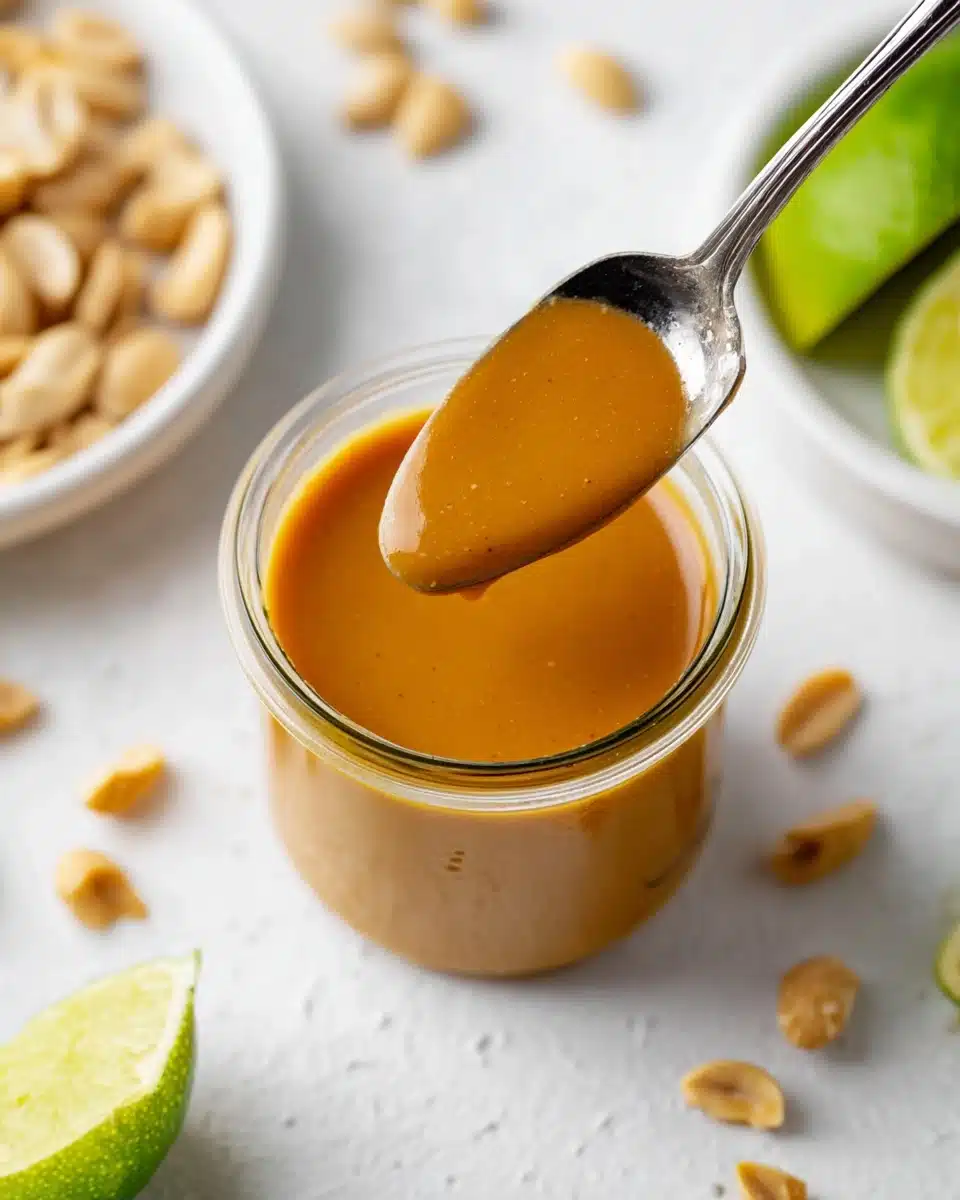If you’ve ever fallen in love with the sweet, tangy, and slightly spicy flavors that make Thai noodles so irresistible, you’re going to be thrilled with this recipe for Pad Thai Sauce! The beauty of this sauce lies in the way it brings everything together—each bite is a dance of savory, sour, and just a hint of heat. Whether you’re drizzling it over noodles, marinating chicken, or experimenting with veggie stir-fries, mastering your own Pad Thai Sauce at home is easier than you think, and the flavor payoff is an absolute game-changer.
Ingredients You’ll Need
The magic of Pad Thai Sauce comes from just a handful of simple ingredients, each one adding its own special touch to the blend. Choose quality ingredients and you’ll taste the vibrant harmony that makes this sauce unforgettable!
- Tamarind paste: Gives the sauce its tart, citrusy punch that’s essential for authenticity.
- Fish sauce: Adds umami depth and a savory backbone—don’t skip this if you want restaurant-style flavor!
- Palm sugar or brown sugar: Lends a mellow sweetness that balances out the acidity and spice.
- Water: Helps thin the sauce just enough to coat noodles perfectly.
- Soy sauce: Brings salty richness and a little added color.
- Rice vinegar: Boosts brightness and tang, making the sauce sing.
- Chili flakes (optional): For a gentle, customizable heat—add as much or as little as you dare!
How to Make Pad Thai Sauce
Step 1: Prep Your Ingredients
Start by measuring out all your ingredients for the Pad Thai Sauce before you get cooking. This simple step makes the actual cooking process easier and helps you avoid missing anything crucial once things start heating up. Trust me, a little organization upfront saves you stress later!
Step 2: Dissolve the Sugar
In a small saucepan set over medium-low heat, combine the palm sugar (or brown sugar) and water. Stir gently until the sugar is completely dissolved—this creates the sweet foundation of your Pad Thai Sauce and ensures no graininess in the finished result.
Step 3: Build the Tang and Umami
Add in the tamarind paste, fish sauce, soy sauce, and rice vinegar. Stir well after each addition so everything melds smoothly. This is the moment where the signature deep, tangy, and slightly funky character of Pad Thai Sauce starts to come alive!
Step 4: Simmer and Adjust
Let the mixture simmer gently for two or three minutes, just until it’s slightly thickened and fragrant. Taste and adjust: crave more tang? A splash more tamarind will do the trick. Want it sweeter? Stir in a touch more sugar. If you’re in the mood for spice, this is where you add those chili flakes to bring the heat up a notch.
Step 5: Cool and Store
Remove the Pad Thai Sauce from the heat and allow it to cool. Once it’s at room temperature, you can use it right away or pour it into a glass jar for later. The flavors deepen as it sits, so don’t be surprised if it’s even more delicious the next day!
How to Serve Pad Thai Sauce

Garnishes
Elevate your finished dish by scattering fresh garnishes over the top. Chopped roasted peanuts, a squeeze of fresh lime, and a handful of crisp bean sprouts make the flavors of the Pad Thai Sauce pop beautifully. A few sprigs of cilantro add a burst of color and a hint of herbal freshness.
Side Dishes
Pad Thai Sauce isn’t just for noodles—it plays nicely with simple sides, too. Try serving it with jasmine rice, grilled vegetables, or alongside crispy tofu for a delightful vegetarian option. A tangy cucumber salad or a bright Thai herb salad can also balance the main dish for a complete feast.
Creative Ways to Present
Think outside the (noodle) box! Use Pad Thai Sauce as a marinade for grilled shrimp or chicken, or drizzle it over roasted veggies for an unexpected twist. It also makes a fabulous dipping sauce for spring rolls or satay skewers, instantly upgrading your appetizers with that signature Thai zing.
Make Ahead and Storage
Storing Leftovers
Keep any leftover Pad Thai Sauce in an airtight container in the refrigerator. It’ll stay fresh and vibrant for up to two weeks, giving you instant flavor for quick weeknight meals or spontaneous stir-fries whenever the craving hits.
Freezing
Pad Thai Sauce freezes beautifully! Portion it into small containers or ice cube trays, then transfer the frozen cubes to a zip-top bag. This way, you can defrost just what you need—perfect for busy evenings or meal prepping ahead.
Reheating
To reheat, simply warm the sauce gently in a small saucepan over low heat, stirring until fluid and glossy again. You can also microwave it in short bursts, stirring in between, but be sure not to overheat or the delicate balance of flavors might be thrown off.
FAQs
Is Pad Thai Sauce gluten-free?
It can be! Just use a certified gluten-free soy sauce or tamari, and double-check your fish sauce, as a few brands sneak in wheat. With those small tweaks, you’ll have a gluten-free sauce suitable for everyone at your table.
What can I use instead of tamarind paste?
If you can’t find tamarind, a mix of equal parts lime juice and a little brown sugar makes an acceptable substitute. The flavor won’t be quite as complex, but it will still give you that lovely sweet-sour balance Pad Thai Sauce is known for.
Can I make Pad Thai Sauce vegetarian?
Absolutely! Swap the fish sauce for a high-quality vegan fish sauce or a combination of soy sauce and a splash of mushroom soy sauce for depth. This way, you keep all the savory notes without any animal products.
How spicy is the sauce as written?
The base Pad Thai Sauce recipe is mild, with just enough chili flakes (if used) to tickle your tastebuds without overpowering the dish. If you prefer more heat, it’s easy to scatter in extra chili or even a dash of sriracha to up the fire.
Can I use Pad Thai Sauce for dishes beyond Pad Thai?
Definitely! This sauce works wonders as a marinade for meats, a stir-fry sauce for vegetables, or even as a zippy dip for dumplings and spring rolls. Once you’ve tasted its bright, tangy depths, you’ll find excuses to drizzle it over just about everything.
Final Thoughts
Once you experience the joy of making your own Pad Thai Sauce, you’ll want to keep a jar on hand at all times. It’s the secret weapon that brings your favorite Thai flavors home, and I can’t wait for you to taste just how easy and delightful it is. Give it a try, and let your kitchen fill with the irresistible aromas of Thailand—your taste buds will thank you!
Print
Pad Thai Sauce Recipe
- Prep Time: 5 minutes
- Cook Time: 0 minutes
- Total Time: 5 minutes
- Yield: 1 cup of sauce 1x
- Category: Sauce
- Method: Mixing
- Cuisine: Thai
- Diet: Vegetarian
Description
This Pad Thai sauce recipe is the perfect balance of sweet, tangy, and savory flavors. It’s easy to make and adds an authentic taste to your homemade Pad Thai dishes.
Ingredients
For the Pad Thai Sauce:
- 3 tablespoons tamarind paste
- 1/4 cup fish sauce
- 1/4 cup rice vinegar
- 1/4 cup brown sugar
- 2 tablespoons soy sauce
- 1 teaspoon chili paste
Instructions
- Prepare the Sauce: In a small bowl, whisk together the tamarind paste, fish sauce, rice vinegar, brown sugar, soy sauce, and chili paste until well combined.
- Use in Your Dish: Add the Pad Thai sauce to your stir-fried noodles and ingredients, tossing everything together until coated evenly.
- Adjust to Taste: Taste and adjust the seasoning by adding more sugar for sweetness, fish sauce for saltiness, or chili paste for heat.
Notes
- This sauce can be stored in an airtight container in the refrigerator for up to a week.
- Adjust the ingredients to suit your personal taste preferences.
Nutrition
- Serving Size: 2 tablespoons
- Calories: 45
- Sugar: 7g
- Sodium: 880mg
- Fat: 0g
- Saturated Fat: 0g
- Unsaturated Fat: 0g
- Trans Fat: 0g
- Carbohydrates: 10g
- Fiber: 0g
- Protein: 1g
- Cholesterol: 0mg




Your email address will not be published. Required fields are marked *